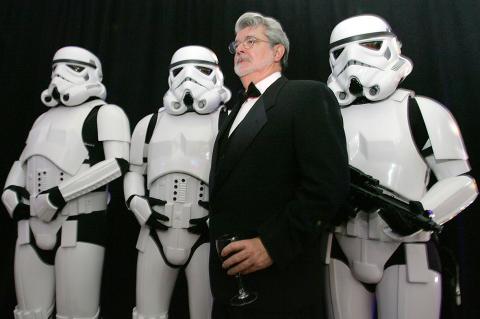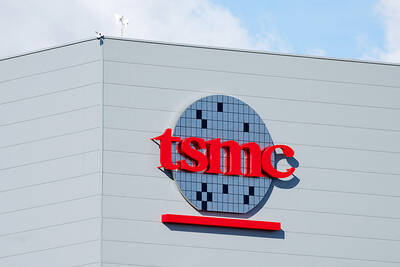Walt Disney Co announced on Tuesday it is buying Star Wars director George Lucas’ film company for US$4 billion and plans to revive the classic sci-fi series starting with a new movie in 2015.
The entertainment giant plans a new trilogy in the legendary franchise, launched with the original Star Wars movie in 1977, while Lucas himself said it was “time for me to pass Star Wars on to a new generation of filmmakers.”
Star Wars 7 will be released in 2015, “with more feature films expected to continue the Star Wars saga and grow the franchise well into the future,” said Disney, announcing the deal to buy pioneering movie company Lucasfilm.

Photo: Reuters
In a conference call with investors, Disney said it planned a new trilogy with films eight and nine, after which more Star Wars movies would be made every two to three years.
The deal “combines a world-class portfolio of content including Star Wars, one of the greatest family entertainment franchises of all time, with Disney’s unique and unparalleled creativity,” Disney chief executive Robert Iger said.
“Lucasfilm reflects the extraordinary passion, vision and storytelling of its founder, George Lucas,” said Iger, head of global entertainment giant Disney, which is headquartered in Burbank, just outside Los Angeles.
The transaction is valued at US$4.05 billion — based on current stock value — with Disney paying about half in cash and issuing approximately 40 million shares at closing. Lucasfilm is 100 percent owned by Lucas.
The first Star Wars film came out in 1977 and there have been two trilogies — three films from 1977 to 1983 and three prequels from 1999 to 2005 — while the brand has expanded into theme parks and a huge merchandising arm.
The movies have earned about US$4.4 billion at the box office globally over the last 35 years, and offer “a virtually limitless universe of characters and stories to drive continued feature film releases,” Disney said.
“The franchise provides a sustainable source of high-quality, branded content with global appeal and is well suited for new business models including digital platforms,” it added.
The acquisition comes after Disney’s takeover of animated film giant Pixar and comic book character-driven Marvel Studios.
Lucas will be succeeded as head of Lucasfilm by his current co-chairman, Kathleen Kennedy, who will report to Walt Disney Studios chairman Alan Horn, Disney said.
“I’m confident that with Lucasfilm under the leadership of Kathleen Kennedy and having a new home within the Disney organization, Star Wars will certainly live on and flourish for many generations to come,” Lucas said.

Taiwan Semiconductor Manufacturing Co (TSMC, 台積電) secured a record 70.2 percent share of the global foundry business in the second quarter, up from 67.6 percent the previous quarter, and continued widening its lead over second-placed Samsung Electronics Co, TrendForce Corp (集邦科技) said on Monday. TSMC posted US$30.24 billion in sales in the April-to-June period, up 18.5 percent from the previous quarter, driven by major smartphone customers entering their ramp-up cycle and robust demand for artificial intelligence chips, laptops and PCs, which boosted wafer shipments and average selling prices, TrendForce said in a report. Samsung’s sales also grew in the second quarter, up

LIMITED IMPACT: Investor confidence was likely sustained by its relatively small exposure to the Chinese market, as only less advanced chips are made in Nanjing Taiwan Semiconductor Manufacturing Co (TSMC, 台積電) saw its stock price close steady yesterday in a sign that the loss of the validated end user (VEU) status for its Nanjing, China, fab should have a mild impact on the world’s biggest contract chipmaker financially and technologically. Media reports about the waiver loss sent TSMC down 1.29 percent during the early trading session yesterday, but the stock soon regained strength and ended at NT$1,160, unchanged from Tuesday. Investors’ confidence in TSMC was likely built on its relatively small exposure to the Chinese market, as Chinese customers contributed about 9 percent to TSMC’s revenue last

With this year’s Semicon Taiwan trade show set to kick off on Wednesday, market attention has turned to the mass production of advanced packaging technologies and capacity expansion in Taiwan and the US. With traditional scaling reaching physical limits, heterogeneous integration and packaging technologies have emerged as key solutions. Surging demand for artificial intelligence (AI), high-performance computing (HPC) and high-bandwidth memory (HBM) chips has put technologies such as chip-on-wafer-on-substrate (CoWoS), integrated fan-out (InFO), system on integrated chips (SoIC), 3D IC and fan-out panel-level packaging (FOPLP) at the center of semiconductor innovation, making them a major focus at this year’s trade show, according

DEBUT: The trade show is to feature 17 national pavilions, a new high for the event, including from Canada, Costa Rica, Lithuania, Sweden and Vietnam for the first time The Semicon Taiwan trade show, which opens on Wednesday, is expected to see a new high in the number of exhibitors and visitors from around the world, said its organizer, SEMI, which has described the annual event as the “Olympics of the semiconductor industry.” SEMI, which represents companies in the electronics manufacturing and design supply chain, and touts the annual exhibition as the most influential semiconductor trade show in the world, said more than 1,200 enterprises from 56 countries are to showcase their innovations across more than 4,100 booths, and that the event could attract 100,000 visitors. This year’s event features 17